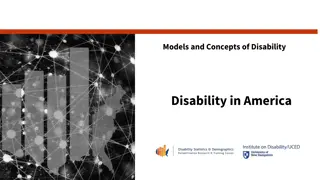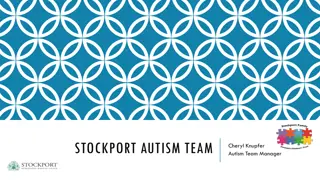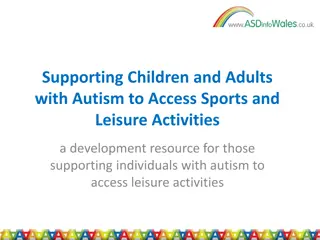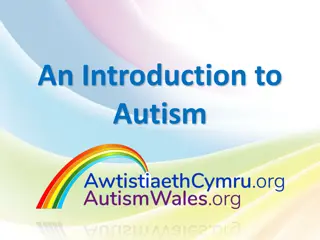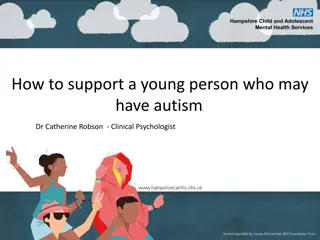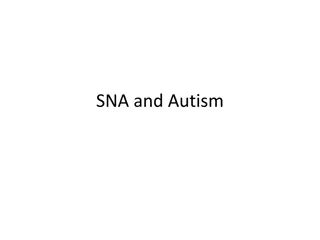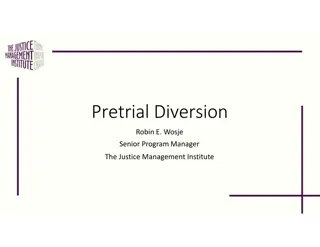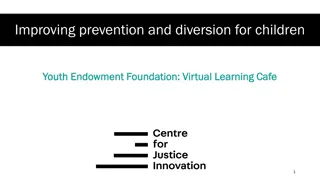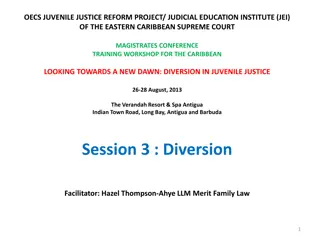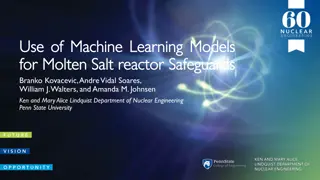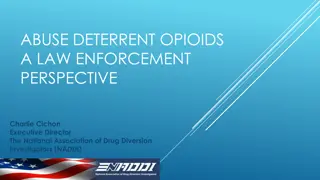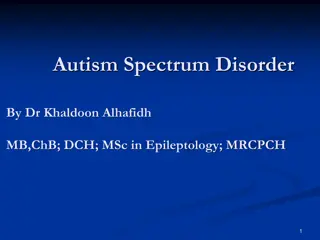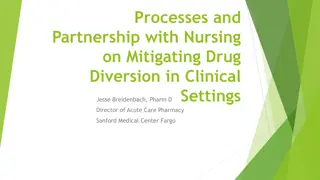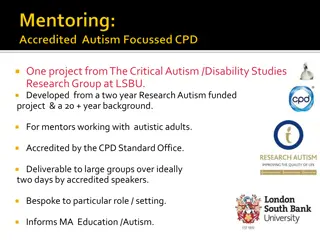Supporting Children and Young People with Learning Disability and Autism in Liaison and Diversion Services
Marie Hunt, Programme Manager, discusses the importance of supporting children and young people with learning disabilities and/or autism in contact with Liaison and Diversion services and Young Offenders Institutions. The research explores key findings, national data, recommendations, and the role of Liaison and Diversion services in identifying vulnerabilities among individuals in the criminal justice system. The wider health and justice context emphasize the need to divert youth away from the criminal justice system and provide support for those with learning disabilities or autism. The study commissioned by NHSE Midlands evaluates the effectiveness of Liaison and Diversion services and Young Offenders Institutions in meeting the needs of children and young people with these conditions.
Download Presentation

Please find below an Image/Link to download the presentation.
The content on the website is provided AS IS for your information and personal use only. It may not be sold, licensed, or shared on other websites without obtaining consent from the author. Download presentation by click this link. If you encounter any issues during the download, it is possible that the publisher has removed the file from their server.
E N D
Presentation Transcript
Supporting children and young people with a Learning Disability and/or Autism in contact with Liaison and Diversion services and Young Offenders Institutions Marie Hunt, Programme Manager September 2023
Agenda Definitions and wider context Research context Key findings: National data Key themes Recommendations
What are L&D services? Liaison and Diversion (L&D) services identify people who have or may have mental health, learning disability, substance misuse or other vulnerabilities when they first come into contact with the criminal justice system as suspects, defendants or offenders (NHS England) Recommended in the 2009 Bradley Report, led by Lord Bradley, as a mechanism to divert people away from the Criminal Justice System Originally recommended for adults but have since expanded remit to CYP The main activities of L&D services are laid out in the Standard Service Specification (2019), and include identification, screening, assessment, and referral to other services.
Wider health & justice context Greater focus placed on both diverting YP away from criminal justice system AND supporting people with LD/A: NHS Health & Justice Framework for Integration (2022-2025) Government announcement in May 2022 to invest 300 million over next 3 years to support LAs to prevent offending earlier (includes Turnaround will provide 60 million to YJSs to improve outcomes for children at risk of offending & who do not meet threshold for statutory support) Other important factors, such as racial disproportionality, not considered in report but the subject of other research
Research context CDC commissioned by NHSE Midlands to conduct review into how effectively L&D services & YOI are supporting & meeting needs of CYP (aged 10-18) with diagnosed or potential learning disability and/or autism (LD/A). Research involved analysing national & local data (LDIP, CYPIP & Health Needs Assessments) & speaking with wide range of stakeholders, including L&D and YOI staff, staff from the wider Youth Justice Service (YJS) and Youth Offending Teams (YOTs), and CYP & families. Clear there are high levels of need & that some YP s LD/A played significant part in leading them to offend. Also clear that there are high levels of commitment to supporting CYP both across L&D services & the YOI. Lots of good practice examples but often reliant on commitment & knowledge of individuals rather than clear processes & pathways.
Key findings: National data 2.5% CYP have a LD in UK (around 353,000) 1.5-1.8% CYP have autism (around 211,1230 253,356) Rates of LD/A higher in some groups (e.g., LAC, prison & YJ populations) Lack of comprehensive prevalence study on rates of LD/A in criminal justice population (recent research suggests rates of LD in adult prison pop. between 7-20%) 2018 study: 20% of CYP in CJS had a LD; 2020 YJS & MoJ report found 71% sentenced YP have significant SLCN Fewer studies into autism in this population (one study cites 4.5%) From available evidence, we predict prevalence of LD 10-20% and autism 2-5% but further research needed
Key findings: local data Health Needs Assessments Significant variation in types of data included Most did not include breakdown of YP engagement with L&D services YOI CSV submission/CYPIP data: Rates of YP with LD/A 2021 Inclusion Team Needs Analysis report- rates of YP with challenges understanding communication, communicating with others, significant learning need. Rates of YP who had CHAT 5 within 10 days of admission, and % reviewed after 12 months Rates of YP discharged to community registered with GP; rates of YP who had discharge summary sent to GP/ shared with another secure setting L&D service data (LDIP) 2020-2022: Variation in what data services collect- some had no data on LD/A, others included rates of YP, referral routes, types of offence & disposal outcomes
Data issue Underlying issue: lack of clear evidence-based picture about numbers of CYP within youth justice system who have LD/A. Commissioners cannot make evidence-based decisions on service design without robust and consistent data. Staff left in untenable position where they know they are leaving issues unaddressed.
Key themes Personalised, consistent & persistent Remit & scope Resource & capacity Processes
Key themes Personalised, consistent & persistent Importance of offering personalised approaches (incl. range of options and contact methods, 1:1 work over group work) Consistent, supportive peer mentors (especially important for CYP with distrust of services) staff who come to work to make a difference Persistently reaching out to CYP in different ways (e.g. home visits, following up and ringing families), particularly important for CYP initially reluctant to engage They (YOT workers) listen to you and have their own take on things, they understand me, and I think they have a good understanding of Aspergers. They don t just go on a rant, they know where I m coming from, they ve witnessed everything from the start (Young person)
Key themes Remit & scope Original purpose of L&D services (for adults/mental health) at odds with presenting need; working with CYP an add-on Differing service thresholds and time spent working with CYP I feel they are between a rock and a hard place when we refer them . if he s talking to me, and won t talk to anyone else, sometimes I wonder why can t we let that continue? (Practitioner, L&D service) Difficulties supporting CYP once they turn 18 Inability to assess CYP in-house Improving our diagnostic ability would be good and having an agreed pathway for assessment of learning disability in place would be good It s just really tricky, especially if we have got concerns but haven t been able to diagnose here for whatever reason (Practitioner, YOI)
Key themes Resource & capacity Workforce capacity: Inconsistent funding (e.g., for SLT & Emotional Wellbeing Workers), & difficulties recruiting & retaining staff Varying offers postcode lottery Variation in workforce knowledge, training & skills (of services available, confidence using assessment tools, especially CHAT 5, referral processes, training needs) When you are doing [a CHAT screening for] your area, you can ask other questions outside the set list which actually help it be a semi-helpful conversation. But I can t do that with CHAT5 I don t know the right questions to ask for that like the other area (Practitioner, YOI)
Key themes - Processes Differing screening tools/processes Effectiveness of screening tools (e.g., timing of CHAT 5, reliance on self-reporting) Inconsistencies in recording & coding data Misidentification is common for example, learning disability going down as [learning] difficulty and vice versa. People put the wrong thing down a lot, and then it doesn t come to the right team (Practitioner, Birmingham L&D service) Challenges with information sharing (e.g. accessing records, chasing up information) Importance of joint working (co-location, joint visits, YOI Enhanced Support Team meetings)
Recommendations For: NHSE Commissioners of L&D services and YOI Wider HMPPS Healthcare providers
Recommendations Commissioners Develop plan to ensure that YP with LD/A are priority group within the scope of L&D services support Explore how YP with suspected LD/A can be either assessed for LD/A by L&D services, or if more streamlined assessment process can be designed Consider how access to specialist expertise could be offered to L&D services e.g. SLT or OT input Develop model for embedding SEND is Everybody s Business message across both YOI and L&D services (e.g. a SEND Champion s network) Review service KPIs to ensure services are incentivised on an outcomes basis, not driven by activity/timescales Address perceived gap in support that exists beyond L&D services. Undertake mapping exercise to map provision that YP can access beyond their engagement with L&D
Recommendations wider HMPPS Conduct research into the prevalence of both learning disability and autism in sentenced YP. Given the consistent theme in research around insufficient capacity to support YP with LD/A within L&D services, it does feel that this research is urgent Address identified skills gap related to basic understanding of LD/A & the wider SEND agenda amongst both the L&D workforce and YOI. We suggest development of a competency framework related to levels of engagement by activity with YP Beyond scope: Explore how YOI can be more environmentally accessible for those YP who have sensory needs (e.g. designated space on a wing)
Recommendations Healthcare providers YOI specific consider recruitment of a specific LD/A specialist role in the clinical team who can assess for LD/A, have responsibility for the CHAT 5 screening, & provide advisory role to the wider team (e.g. Born in Bradford model of autism assessment in school) Consider the CHAT 5 assessment being carried out a at a later stage, including a way to capture any observations made of the young person since arriving in the institution in the process In YOI, consider Enhanced Support Team meetings being held with the YP in attendance for the full meeting
Final reflections For questions/comments about the research, please contact Marie at mhunt@ncb.org.uk
Postevaluation form If you re leaving us now, please fill out the post- evaluation form through this link or scan the QR code: https://iassn.onlinesurveys.ac.uk/the-future-of-send- system-improvement-national-event-2 ncb.org.uk




